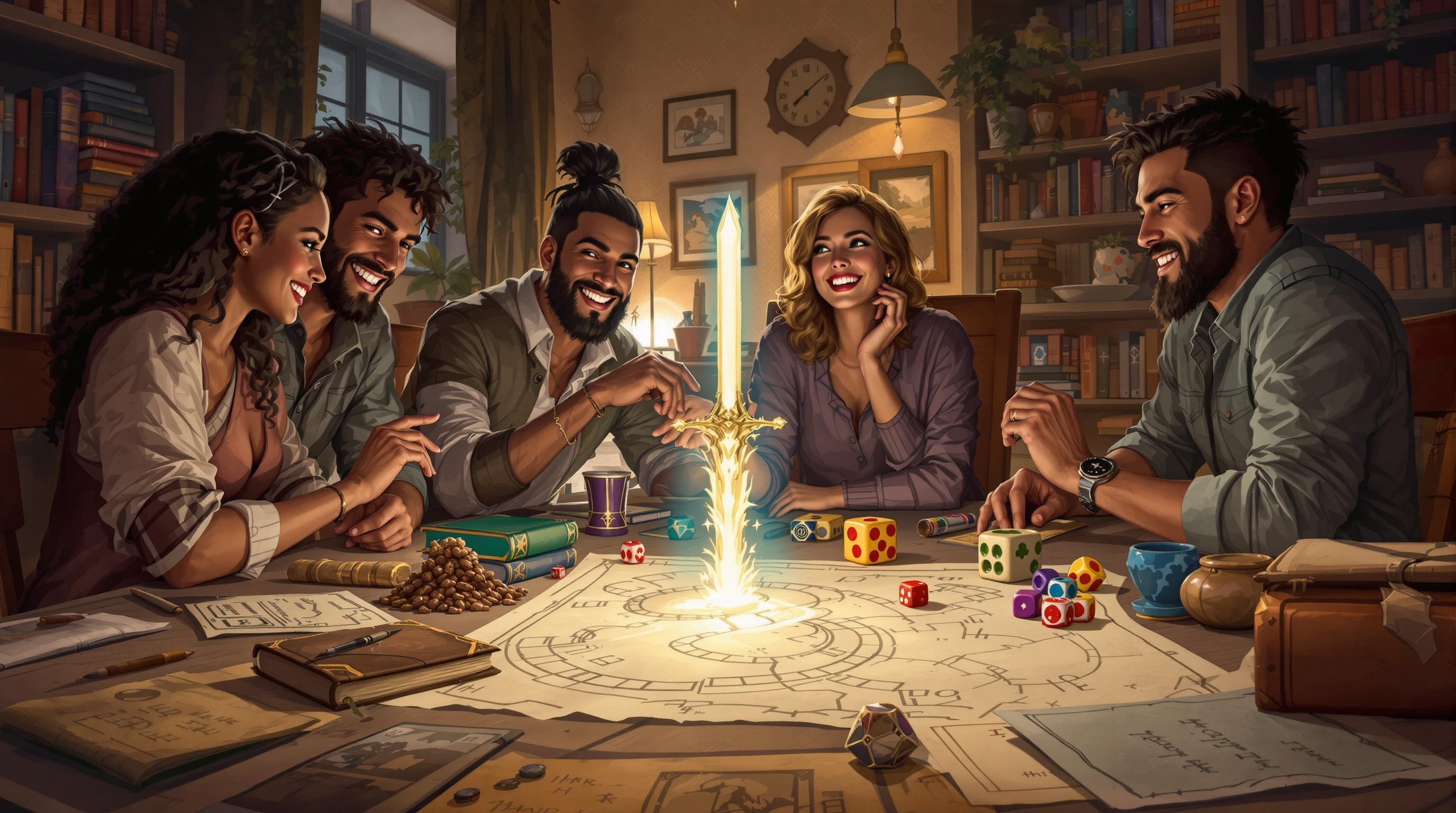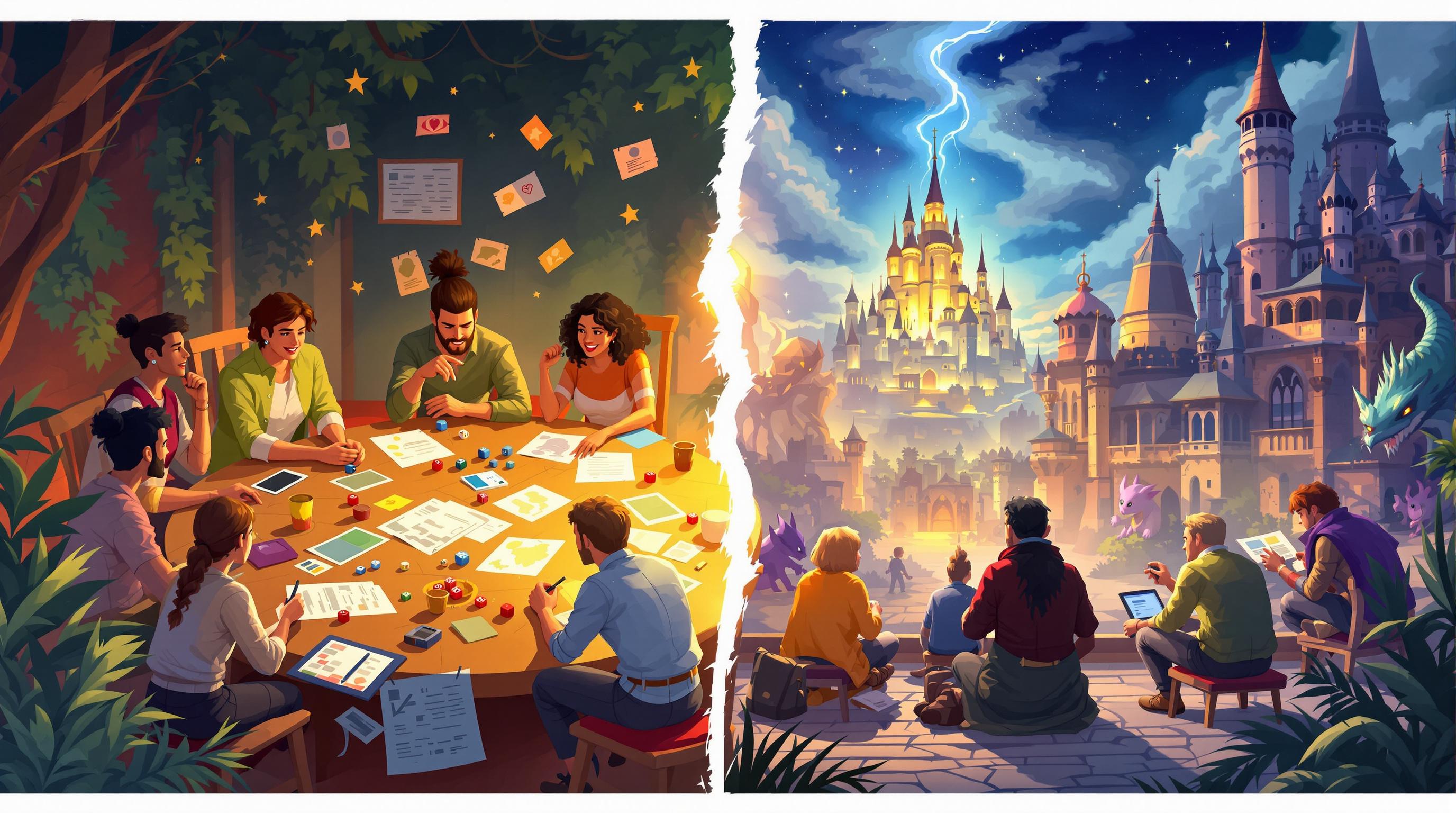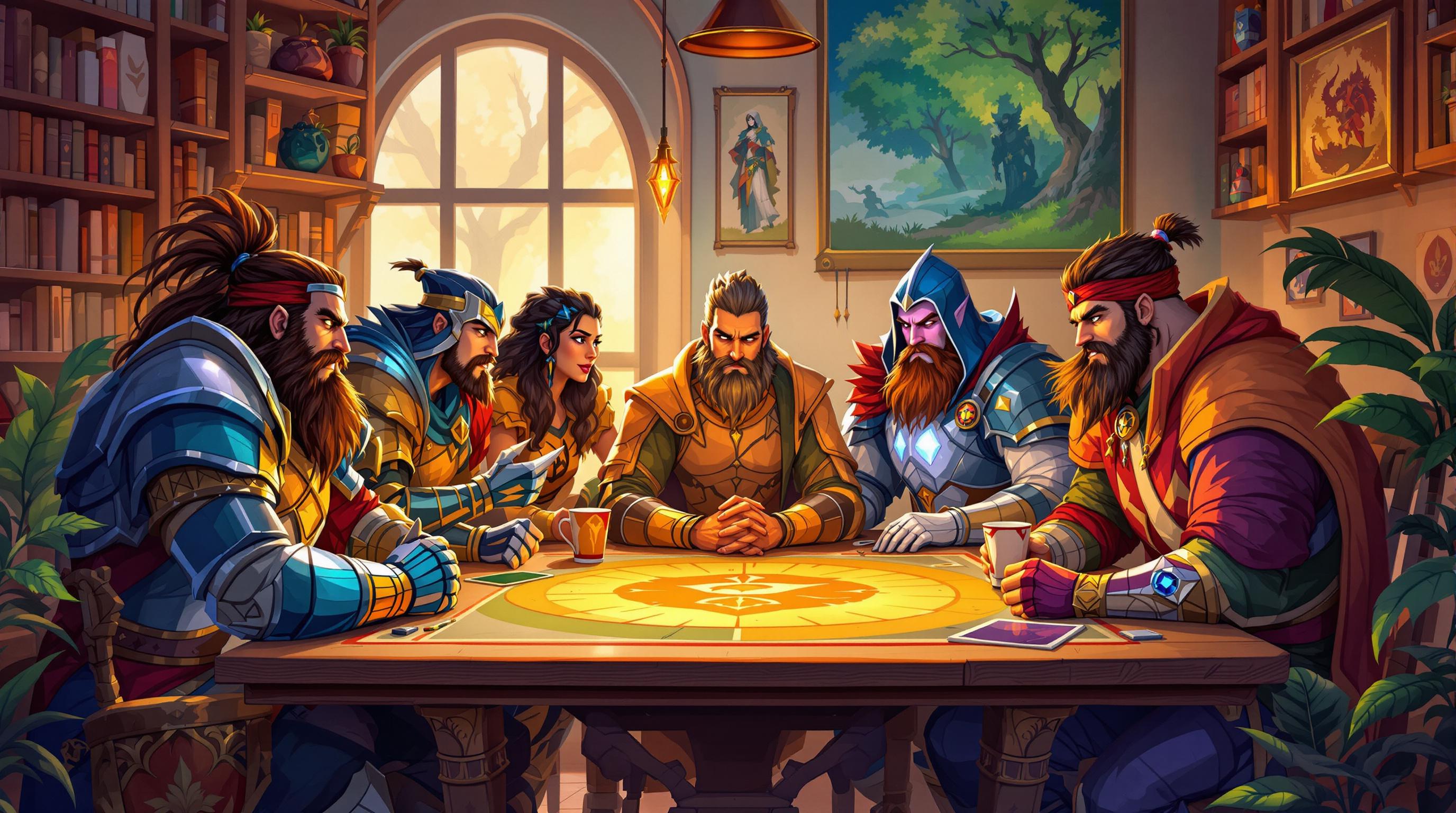Creating character leitmotifs for RPGs involves crafting memorable melodies that reflect a character’s personality, emotions, and story arc. Leitmotifs are short, recurring musical themes tied to characters, enhancing emotional connections and storytelling. Here’s a quick breakdown:
-
What Are Leitmotifs?
Recurring musical phrases representing characters, actions, or ideas. -
Why Use Them?
- Build emotional connections.
- Highlight character growth.
- Enhance storytelling moments.
-
How to Create Them:
- Understand Your Character: Identify traits, history, and emotional range.
- Choose Instruments: Match sounds to the character (e.g., brass for a warrior, piano for a tragic hero).
- Compose a Simple Melody: Use clear, short phrases that are easy to adapt.
- Adapt Themes: Modify key, tempo, or instrumentation to reflect character growth or story events.
-
When to Use Them:
During introductions, key story moments, or to signal emotional shifts.
Tools like Bardly.io or Dungeon Soundtracker can help you create and adapt these themes for your game. Leitmotifs make RPGs more immersive by tying music to characters and their journeys.
Related video from YouTube
Character Analysis
Creating effective leitmotifs starts with a deep understanding of your character's traits, history, and emotions. This groundwork helps craft musical themes that connect with players and enhance the story.
Core Personality Elements
Start by identifying your character's standout traits. These will shape your musical choices. For instance, a bold warrior might be represented by powerful brass instruments, while a mysterious mage might be captured with airy synthesizer tones .
Key elements to consider:
- Dominant Traits: What defines their personality?
- Character Archetype: Their role in the story.
- Behavioral Patterns: How they act and respond in various situations.
- Relationships: Their connections with other characters.
Tying these traits to a character's history adds depth to their musical identity.
Story and Background
Howard Shore’s work in The Lord of the Rings is a prime example of how a character’s history can shape their musical theme .
Focus on these aspects:
- Origin Story: Where are they from?
- Key Life Events: What moments shaped them?
- Cultural Identity: Their heritage and traditions.
- Development: How they evolve throughout the story.
This context helps build emotional layers into the leitmotif, making it more reflective of the character's journey.
Emotional States
A character's emotional range should influence how their theme evolves. Take Star Wars, for example: Luke’s theme shifts from a triumphant fanfare during heroic moments to softer, subdued versions during times of doubt .
Here’s how different emotional states can translate into music:
| Emotional State | Musical Approach |
|---|---|
| Heroic/Triumphant | Full orchestration, major key |
| Uncertain/Afraid | Gentle dynamics, minor key |
| Determined | Steady tempo, strong rhythmic drive |
| Vulnerable | Sparse instrumentation, slower tempo |
In Final Fantasy XV, each character's theme evolves with their emotions while staying true to its core, creating a stronger bond between the players and the characters .
These principles lay the groundwork for crafting meaningful and dynamic musical themes.
Building the Music
Turn your character's personality into a memorable leitmotif by following these steps.
Instrument Selection
Choose instruments that represent your character’s personality and background. For instance:
- A bold warrior might be represented by brass and timpani.
- A mysterious mage could use synthesizers and woodwinds.
- A noble leader might suit a string orchestra.
- A tragic hero could be captured with a solo piano and strings.
Once you’ve picked the instruments, focus on crafting a short, memorable melody.
Melody Creation
A strong melody combines simplicity and clarity. Dante Fumo explains:
"When it comes to writing a leitmotif, how do you want to communicate the essence of character or theme in a melody? For starters, you'll want to keep it simple with a one- or two-bar theme without too much rhythmic complexity. If your motif is too long or complex, it won't be as memorable, and it will become more difficult to modify it later on."
Here’s what to keep in mind:
- Key Choice: Major keys often evoke strength or positivity, while minor keys lean toward mystery or sadness.
- Melodic Movement: Ascending melodies can symbolize growth or victory, while descending ones might suggest decline or uncertainty.
- Rhythm: Match the tempo to your character’s personality – fast and lively, or slow and thoughtful.
Musical Structure
After finalizing the melody, structure it for flexibility so it can adapt to different moments. A great example is Aerith's Theme from Final Fantasy VII, where the melody evolves with the story .
Key components to include:
- Core Motif: A simple, easily recognizable musical phrase.
- Variations: Different arrangements to reflect changing emotions.
- Layering Options: Elements that can be added or removed to match the scene’s intensity.
This dynamic approach allows your leitmotif to evolve with your story. For example, The Legend of Zelda: Ocarina of Time subtly adjusts its field theme throughout the day, keeping the core melody intact while modifying the arrangement to suit the mood.
sbb-itb-b8b00a5
Using Leitmotifs in Games
Theme Variations
Adjusting themes for different story moments requires careful tweaks. Matthew Bribitzer-Stull's research outlines some critical techniques:
- Changing key modes and harmonies to reflect emotional shifts
- Altering instrumentation density to match scene intensity
"When these two sets of features are blended together, it yields 'musico-dramatic statements' and associations that 'develop in tandem with musical and dramatic developments'"
A great example of this is in The Lord of the Rings. The "Into the West" leitmotif uses inverted melodic patterns to represent story resolution. The transformation of the fa–mi interval from the original ♯4̂–5̂ motive creates a strong sense of closure .
This kind of variation helps ensure themes align perfectly with key moments in the narrative.
When to Play Themes
In The Good, the Bad and the Ugly, each character has a unique musical theme that plays during their entrance. Blondie's heroic melody sharply contrasts with Angel Eyes' menacing theme, making character recognition immediate .
Some key moments for using character themes include:
- Introductions
- Major story developments
- Confrontations
- Emotional turning points
- Background cues in relevant scenes
"Leitmotifs are not just a compositional tool but also have a profound psychological impact on audiences… The consistent association of a musical theme with a particular element of the film creates a conditioned response, where the music alone can evoke the corresponding emotions and memories."
Modern music creation tools make timing and deploying these themes more manageable than ever.
Music Creation Tools
Today's tools offer plenty of options for implementing leitmotifs effectively:
| Tool | Key Features | Best For |
|---|---|---|
| Bardly.io | - Pre-made atmospheres - Custom track import - Mobile accessibility |
Quick implementation and ease of use |
| Dungeon Soundtracker | - Real-time generation - Adjustable parameters - Root note/tempo control |
Technical control and unique soundscapes |
These tools allow you to tweak core melodies by adjusting elements like:
- Root note and tempo
- Mode and scale
- Reverb and chorus effects
- Instrument combinations
For example, using Dungeon Soundtracker, you could shift a hero's theme from triumphant to somber by modifying the mode and adding reverb . This flexibility ensures your themes stay consistent while adapting to different gameplay scenarios.
TTRPG Games Directory Resources
Directory Search Tips
The TTRPG Games Directory makes it easier to find games that highlight musical elements and character development. If you're looking for RPGs that incorporate character leitmotifs, try using these key filters:
| Category | What to Look For | Why It Matters |
|---|---|---|
| Game Style | Narrative-driven, Character-focused | These games often provide more opportunities for personalized musical development. |
| Theme | Mythology, Fantasy, Epic | These themes typically come with rich lore and dynamic musical possibilities. |
| Mechanics | Story-first systems, Dramatic play | Such systems naturally support character-specific musical moments. |
By combining these filters, you can narrow down games that focus on musical storytelling before diving into detailed reviews.
Game Analysis Examples
Once you've identified potential games, take a closer look at how they incorporate character themes and musical cues. Here's how to evaluate their potential for leitmotifs:
-
Review Game Mechanics
Look for systems that include:- Milestones for character development.
- Emotional state tracking.
- Scene-setting mechanics. These features create natural opportunities for character-specific music.
-
Examine Theme Integration
Check for descriptions that emphasize:- Settings tied to bardic traditions.
- Character classes with musical abilities.
- Systems rewarding dramatic character moments.
-
Study Game Features
Focus on titles offering:- Tools for integrating music directly into gameplay.
- Scene management systems.
- Strong frameworks for character development.
These steps can help you use the TTRPG Games Directory to find games where character leitmotifs enrich the storytelling experience, without requiring major system adjustments.
Summary
Crafting effective character leitmotifs involves blending musical elements with a character's personality and story arc. These motifs are usually just one or two bars long, featuring simple rhythms that evoke strong emotions. Here are some examples of how musical elements can align with different character types:
| Character Type | Musical Elements |
|---|---|
| Heroes | Bold, ascending melodies emphasizing tonic and dominant notes (e.g., The Imperial March) |
| Villains | Descending minor scales with dissonant tones (e.g., the ominous bass riff from Jaws) |
| Wise Characters | Simple, gentle melodies paired with soft instrumentation (e.g., Syd's Theme) |
"The leitmotif...is a versatile concept that breathes life into soundtracks." - Victor Li, Author at SUPERJUMP
For inspiration, check out the TTRPG Games Directory, which highlights games with innovative musical storytelling. Look for titles that pair strong character arcs with creative use of music - these are great examples of how leitmotifs can deepen emotional engagement and enhance storytelling.
To keep your leitmotifs fresh and aligned with your narrative, adapt them as your characters grow. Experiment with changes in key, instrumentation, or rhythm to reflect shifts in the story while keeping the core melody recognizable. Use leitmotifs strategically during character introductions, major plot twists, or atmospheric moments to tie the music directly to the narrative, creating a richer and more immersive experience.


